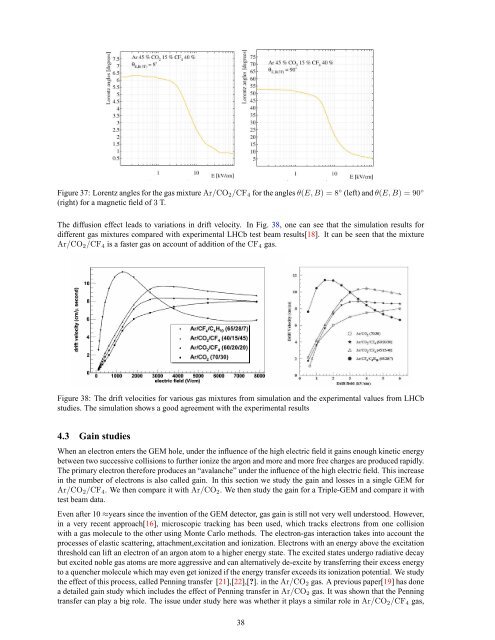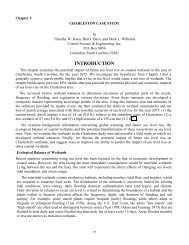A GEM Detector System for an Upgrade of the CMS Muon Endcaps
A GEM Detector System for an Upgrade of the CMS Muon Endcaps
A GEM Detector System for an Upgrade of the CMS Muon Endcaps
You also want an ePaper? Increase the reach of your titles
YUMPU automatically turns print PDFs into web optimized ePapers that Google loves.
Figure 37: Lorentz <strong>an</strong>gles <strong>for</strong> <strong>the</strong> gas mixtureAr/CO2/CF4 <strong>for</strong> <strong>the</strong> <strong>an</strong>glesθ(E,B) = 8 ◦ (left) <strong>an</strong>dθ(E,B) = 90 ◦<br />
(right) <strong>for</strong> a magnetic field <strong>of</strong> 3 T.<br />
The diffusion effect leads to variations in drift velocity. In Fig. 38, one c<strong>an</strong> see that <strong>the</strong> simulation results <strong>for</strong><br />
different gas mixtures compared with experimental LHCb test beam results[18]. It c<strong>an</strong> be seen that <strong>the</strong> mixture<br />
Ar/CO2/CF4 is a faster gas on account <strong>of</strong> addition <strong>of</strong> <strong>the</strong> CF4 gas.<br />
Figure 38: The drift velocities <strong>for</strong> various gas mixtures from simulation <strong>an</strong>d <strong>the</strong> experimental values from LHCb<br />
studies. The simulation shows a good agreement with <strong>the</strong> experimental results<br />
4.3 Gain studies<br />
When <strong>an</strong> electron enters <strong>the</strong> <strong>GEM</strong> hole, under <strong>the</strong> influence <strong>of</strong> <strong>the</strong> high electric field it gains enough kinetic energy<br />
between two successive collisions to fur<strong>the</strong>r ionize <strong>the</strong> argon <strong>an</strong>d more <strong>an</strong>d more free charges are produced rapidly.<br />
The primary electron <strong>the</strong>re<strong>for</strong>e produces <strong>an</strong> “aval<strong>an</strong>che” under <strong>the</strong> influence <strong>of</strong> <strong>the</strong> high electric field. This increase<br />
in <strong>the</strong> number <strong>of</strong> electrons is also called gain. In this section we study <strong>the</strong> gain <strong>an</strong>d losses in a single <strong>GEM</strong> <strong>for</strong><br />
Ar/CO2/CF4. We <strong>the</strong>n compare it with Ar/CO2. We <strong>the</strong>n study <strong>the</strong> gain <strong>for</strong> a Triple-<strong>GEM</strong> <strong>an</strong>d compare it with<br />
test beam data.<br />
Even after 10≈years since <strong>the</strong> invention <strong>of</strong> <strong>the</strong> <strong>GEM</strong> detector, gas gain is still not very well understood. However,<br />
in a very recent approach[16], microscopic tracking has been used, which tracks electrons from one collision<br />
with a gas molecule to <strong>the</strong> o<strong>the</strong>r using Monte Carlo methods. The electron-gas interaction takes into account <strong>the</strong><br />
processes <strong>of</strong> elastic scattering, attachment,excitation <strong>an</strong>d ionization. Electrons with <strong>an</strong> energy above <strong>the</strong> excitation<br />
threshold c<strong>an</strong> lift <strong>an</strong> electron <strong>of</strong> <strong>an</strong> argon atom to a higher energy state. The excited states undergo radiative decay<br />
but excited noble gas atoms are more aggressive <strong>an</strong>d c<strong>an</strong> alternatively de-excite by tr<strong>an</strong>sferring <strong>the</strong>ir excess energy<br />
to a quencher molecule which may even get ionized if <strong>the</strong> energy tr<strong>an</strong>sfer exceeds its ionization potential. We study<br />
<strong>the</strong> effect <strong>of</strong> this process, called Penning tr<strong>an</strong>sfer [21],[22],[?]. in <strong>the</strong>Ar/CO2 gas. A previous paper[19] has done<br />
a detailed gain study which includes <strong>the</strong> effect <strong>of</strong> Penning tr<strong>an</strong>sfer in Ar/CO2 gas. It was shown that <strong>the</strong> Penning<br />
tr<strong>an</strong>sfer c<strong>an</strong> play a big role. The issue under study here was whe<strong>the</strong>r it plays a similar role in Ar/CO2/CF4 gas,<br />
38
















